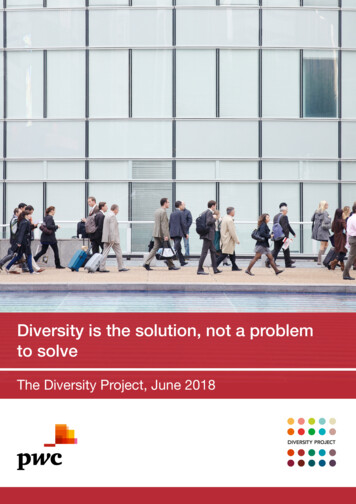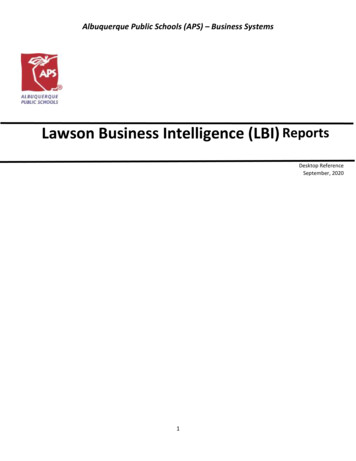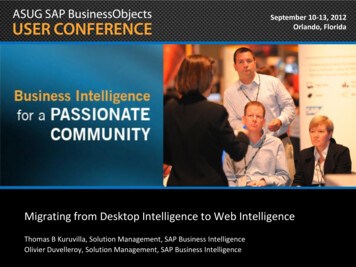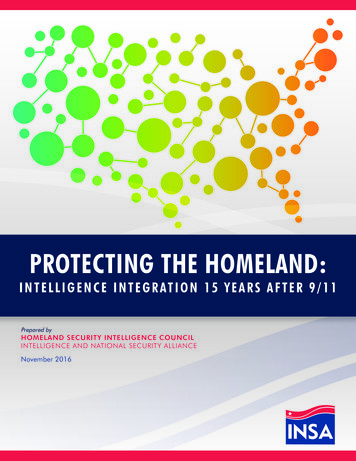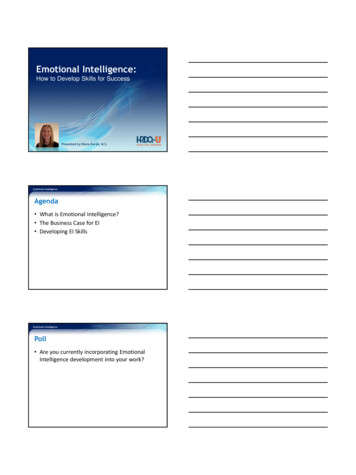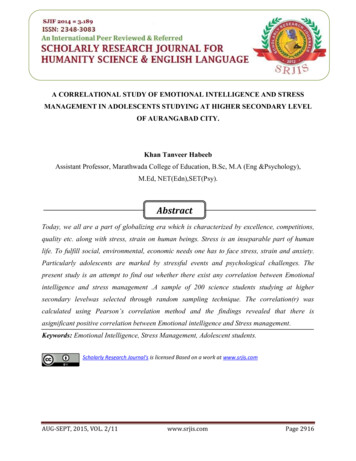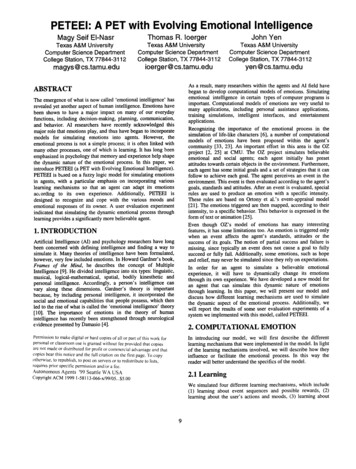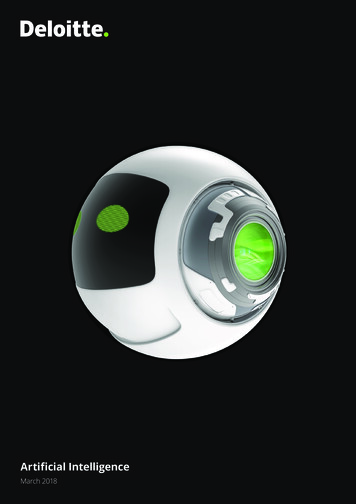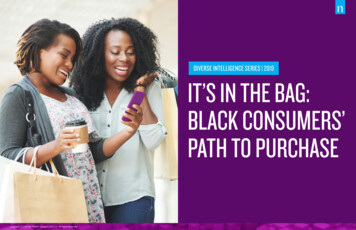
Transcription
DIVERSE INTELLIGENCE SERIES 2019IT’S IN THE BAG:BLACK CONSUMERS’PATH TO PURCHASE1Copyright 2019 The Nielsen Company (US), LLC. All Rights Reserved.
PREFACEThere is a saying, “Be careful what you ask for because you just might get it.” In 2011 when Nielsen launched the firstcomprehensive report on the buying habits and behaviors of African American consumers, we simply wanted to raise awarenessof the economic clout Black consumers yielded as an opportunity for brands to be more inclusive. Eight years later the level ofawareness has indeed been raised, but inclusion is still very much a work in progress.Some industries and brands have grown markedly more diverse and inclusive while others have opted to change only whenforced to do so following unfortunate missteps. Still others have not yet ventured into change at all. Those are the brands we stillhope to inspire.As we explore the African American path to purchase, we recognize that advertising is the indispensable first step of the journey.Yet the advertising industry has been slow to align Blacks’ consumption habits with brands’ advertising spend focused on Blackaudiences; or to diversify the industry itself to ensure it reflects this cohort’s 1.3 trillion in spending power. We delve deeperinto this topic in our special section on advertising.Cheryl GraceSVP, U.S. StrategicCommunity Alliancesand ConsumerEngagementMia Scott-AimeVP, CommunicationsAt Nielsen, we are charged with helping our clients see ahead of the curve. What we know to be true—because we’ve crunchedthe numbers over and over—is this: diversity is not a moment. Or a trend. It will not pass. Or go away. But brands that continueto fail to recognize this reality just may. So we keep trying to spread the word. This year we have asked for a little help from someof the brightest minds in the industry, to help contextualize the opportunity of the Black consumer market for those brands wehaven’t reached yet. We want to ignite a movement of positive, progressive change. And with industry leaders on our side—wethink we might just get it.EDITOR’S NOTEAfrican American population numbers throughout this reportare reported as defined by the U.S. Census as “Black alone or incombination with other races.” This decision is a nod to the greaterdiversity of the African American population in the U.S.2Copyright 2019 The Nielsen Company (US), LLC. All Rights Reserved.
EXECUTIVE SUMMARYAfrican Americans’ influence on mainstream culture is clear. Fifty-four percent of African Americans are34 years old or younger, meaning the majority of Blacks have grown up in the digital age, and thesepowerful consumers have naturally incorporated their tech-affinity into their entire shopping journey.This pursuit of the latest things drives many steps on the African American consumer journey, fromhow they consume media to become aware of trends and products, to how they use e-commerce onmultiple devices while still demanding a dynamic in-store experience.AFFINITY FOR APPS AND CREATING WHERE THERE ARE GAPSAfrican Americans over-index the total population for most genres of apps, including search engines,entertainment, electronics, Government & Non-Profit apps. The rise of apps like the Official BlackWall Street and I Am Black Business create easy access to information about African Americanowned businesses, and their creation is impacting African Americans’ ability to support black-ownedbusinesses with their purchasing power.Black Americans are 48 million strong with nearly 25 million being millennial age or younger as of2018. With a median age of 32, Black Americans are just approaching their peak earning years, but arealready dominating industries from music to fashion and many others and creating apps and digitalBLACK RADIO & MUSIC DOMINATE LISTENINGspaces to serve their own unique needs when the opportunity demands it.Radio has the highest weekly reach (92%) among adult African Americans and listening happens allIn a world bombarded by constant new media options and technologies, companies that want Africandominate the music scene, with Urban AC (Adult Contemporary) the leading genre of choice for AfricanAmerican consumers’ dollars must understand what most influences these consumers and how theyinfluence others on their path to purchase. Developing authentic strategies that evolve from listeningto Black consumers’ needs and demands is not only the best way, but the only way for brands to realizeday long with 35% happening in the home and 64% away from home. African American music genresAmericans 18 with a 29.3% market share among 18 African Americans, then followed by UrbanContemporary at 20.3%, and Rhythmic CHR, Adult Contemporary and News/Talk rounding out the top 5.the powerful growth opportunity ahead.RECEPTIVE TO ADVERTISINGTECH AFFINITY DRIVES THE CONSUMER JOURNEYAfrican Americans demand that product information and feedback opportunities be integrated acrossAfrican Americans are adopting new and multiple devices at higher rates than the total U. S. andadvertising provides them with meaningful information about the product use of other consumers onadapting those devices to their unique consumer journey. Ninety-six percent of African Americanhouseholds own a smartphone, and those aged 35 surpass the total population in their age group by2% for smartphone ownership.OMNICHANNEL MEDIA CONSUMERS WITH SHIFTS ON THE HORIZONmultiple media channels. African Americans are more likely than the total population to agree thatmost platforms including on mobile phones (42% higher), television (23% higher), radio (21% higher),and on the internet (18% higher).BUYING LOCAL AND CONCERNS ABOUT ENVIRONMENT AND FOOD SAFETYAfrican Americans are buying local more often with their definition of “local” varying across differentAfrican Americans are voracious media consumers, across multiple channels, spending over 11 hoursfood categories The top 3 environmental/food safety concerns among Black consumers are: “Pesticide/more each week using television (50:38 hrs per week) compared to the total population. “Internet onherbicide use in food production” (76%), “Antibiotic use in animal production” (71%), and “Rising pricesthe go,” usage is increasing with more time spent on video, audio and social networking than the totaldue to trade tariffs” (68%–21% higher than the total population).population on both smartphones and tablets.SOCIAL MEDIA SUPERSTARSFacebook has the highest reach of social media apps with African Americans at 66%, but usageis 4% lower than the total population. Facebook-owned Instagram, however, reaches 45% ofAfrican Americans (surpassing the total population by 20%, the highest preference differencevs. the total population of all of these ranked social apps).SHIFTING GEOGRAPHIES: TEXAS TAKES THE LEADBlack buying power continues to grow, from 320 billion in 1990 to 1.3 trillion in 2018. Between2000 and 2018, black buying power rose 114%, compared to an 89% increase in white buying power.Texas now has the largest population of African Americans and tops the nation in African Americanbuying power.3Copyright 2019 The Nielsen Company (US), LLC. All Rights Reserved.
TABLE OF CONTENTSINFLUENCES AND INFLUENCERS ALONG THE AFRICAN AMERICANCONSUMER JOURNEY. 5Angela Rye Guest Commentary. 32African Americans of All Ages Love Their Tech Devices. 7Black Beauty. 33There’s an App for That: Black Consumers Creating Apps to AnswerTheir Unique Needs. 10Younger Households Increase in Baby Products Spend. 34Highest Reach Apps Within Categories. 12Aspiration and The African American Consumer Journey. 14Top 20 High Indexing African American Grocery Products vs. General Market. 35Why In-Store Shopping Still Matters. 36The Feedback Loop: Passion and Power in Recommendations. 37The Rise of TV Content Portraying Nuanced and Layered African American Stories. 15Popular Radio Formats With Younger and Older African Americans. 17The Power and Influence of Hip-Hop Music – and Beyond. 18Omnichannel Advertising – The Physical and the Digital. 20The State of Advertising to African American Consumers. 21AFRICAN AMERICAN DEMOGRAPHIC TRENDS AND ECONOMICS. 39The U.S. Census Bureau – Nielsen 2020 Partnership. 40Growing Consumer Base. 42The Impact of Growing College Enrollment. 44AFRICAN AMERICAN POWER AT THE POINT OF PURCHASE. 25The Pre-Store Influencers of African American Consumers. 26Attitudes & Behaviors at Point of Purchase. 27Local Sourcing and Food Safety are Top of Mind. 27Attitudes & Behaviors at Point of Purchase. 29Geographic Distribution of Black American Buying Power. 45CONCLUSION. 47METHODOLOGIES. 49In-Store Influencers at the Point of Purchase. 29Shopping Channel Preferences. 31The Power of African American Dollars. 324Copyright 2019 The Nielsen Company (US), LLC. All Rights Reserved.
INFLUENCES ANDINFLUENCERS ALONGTHE AFRICAN AMERICANCONSUMER JOURNEYThe path to purchase, or “consumer journey” is non-linear and circular, but finds a logicalend at the purchase point. But, where does the consumer journey begin? It starts whereconsumers learn about products—through advertising, the recommendations of friends,family and online communities and the consumer’s own searching. So much of productdiscovery takes place on mobile devices, which is important because Black consumers aremuch more likely to own a variety of devices and spend more time on these devices than thetotal population. However, smart marketers will not overlook traditional media platformswhen designing Black outreach plans. After all, Black consumers love all forms of media, andspend more time with media on traditional platforms like TV and radio. The key to earningBlack consumer spend is reaching Black consumers as they research and discover theproducts they need.5Copyright 2019 The Nielsen Company (US), LLC. All Rights Reserved.
INFLUENCES AND INFLUENCERS ALONG THE AFRICAN AMERICAN CONSUMER JOURNEYSixty-one percent of African Americans respond positivelyto the statement “I’m fascinated by new technology.”African Americans are also 37% more likely than thetotal population to be the first among their peers totry new technology products, and they are 43% morelikely to agree with the statement “I like to have a lot ofgadgets.” African Americans actively embrace technology,and its impact on their shopping behaviors, being 54%more likely than the total population to agree with thestatement “I want others to say wow when they see myelectronics.” This passion for the latest technology drivesmany steps on the African American consumer journey— not only how they consume media to become aware ofproducts and services, but also how seamlessly they usee-commerce on these new and multiple devices, while stillenjoying the in-store experience.61%OF AFRICAN AMERICANS AGREE“I’M FASCINATED BY NEWTECHNOLOGY.”THE NON-LINEAR PATH TO PURCHASESEARCHTV VIEWSPRINTADSDISPLAYADSSOCIALMEDIA6Copyright 2019 The Nielsen Company (US), LLC. All Rights Reserved.
INFLUENCES AND INFLUENCERS ALONG THE AFRICAN AMERICAN CONSUMER JOURNEYAFRICAN AMERICANS OF ALL AGES LOVE THEIR TECH DEVICESAfrican Americans are adopting new devices andmultiple devices at higher rates than the general U.S.population, and they’re adapting those devices to theirunique consumer journeys. Ninety-six percent of AfricanAmericans own a smartphone, and those aged 35 surpass the total population in their age group by 2% forsmartphone ownership. In fact, African Americans makeup 23% of the total market for U.S. cellular sales, whileonly accounting for 14% of the overall population.AFRICAN AMERICAN DEVICE OWNERSHIPALL AGES ETINTERNET-CONNECTED DEVICEVIDEO GAME %65%70%74%83%SMARTPHONETABLETINTERNET-CONNECTED DEVICEVIDEO GAME CONSOLECOMPUTERS1009598938935 94%92%61%68%42%41%42%41%70%81%AFRICAN AMERICANSMARTPHONETABLETINTERNET-CONNECTED DEVICEVIDEO GAME CONSOLECOMPUTERSTOTAL POPULATION1019010310287INDEX, AFRICAN AMERICAN VS. TOTALSource: Nielsen NPOWER, April 2019, based on households/persons installed in the National TV panel7Copyright 2019 The Nielsen Company (US), LLC. All Rights Reserved.
INFLUENCES AND INFLUENCERS ALONG THE AFRICAN AMERICAN CONSUMER JOURNEYAfrican Americans are avid media consumers—acrossmultiple media channels—which gives advertisers ampleopportunities to connect with them. African Americansspend more time on devices compared to the samequarter last year, as they embrace new technologiesand the proliferation of new devices. African Americansspend considerably more time with television each weekthan the total population (50:38 vs. 39:06), the total timespent is down one hour and 20 minutes each week from2018. To make up for the lost TV time, Black consumersin 2019 are active in using “Internet on the go,” spendingmore time on video, audio and social networking than thetotal population on both smartphones and tablets. Notonly are African Americans spending more time on thesedevices, they are spending more time using them thanthe total population: They spend over three hours moreon websites/apps on smartphones (29:46 vs. 26:31) andnearly an hour more on tablets (13:36 vs. 12:47).WEEKLY TIME SPENT ON DEVICE: ADULT USERS, AGES 18 AFRICAN AMERICANTOTAL POPULATIONTotal use of television50:3839:06Live time-shifted TV44:4133:59Time-shifted TV6:417:15TV-connected devices12:3410:42DVD/Blue-ray device5:144:11Game console11:149:47Internet-connected device10:409:01Radio13:4113:06Internet on a computer6:167:121:282:07Video on a computer2:402:28App/web on a smartphone29:4626:31Video-focused app/web on a tablet3:102:19Streaming audio1:030:57Social networking7:206:3313:3612:47Video-focused app/web on a tablet3:212:49Streaming audio0:440:33Social networking2:382:29Q1 2019Social networkingApp/web on a tabletBLACK CONSUMERS ARE ACTIVEIN USING “INTERNET ON THE GO,”WITH MORE TIME SPENT ONVIDEO, AUDIO AND SOCIALNETWORKING THAN THETOTAL POPULATION ON BOTHSMARTPHONES AND TABLETS.Copyright 2019 The Nielsen Company (US), LLC. All Rights Reserved.Source: Nielsen Total Audience Report, Q1 20198
INFLUENCES AND INFLUENCERS ALONG THE AFRICAN AMERICAN CONSUMER JOURNEYRadio has the highest weekly reach for African Americansat 92%. The reach of total TV for African American adults is91%, and content is primarily consumed through live plustime-shifted TV. For any media channel—be it audio, videoor digital—the use of smartphone devices outreaches theuse of PCs and tablets by large margins.The high weekly reach of media and the ample time thatAfrican American consumers spend with their devicespresent an array of opportunities for marketers lookingto connect with Black consumers where they live theirdigital lives.WITH A 92% WEEKLY REACH,RADIO IS THE MOST RELIABLE MEDIAPLATFORM FOR ADVERTISERS TOREACH BLACK CONSUMERS.WEEKLY REACH (%): ADULT USERS, AGES 18 TOTAL USE OF TELEVISIONLIVE TIME-SHIFTED TVTIME-SHIFTED TVTV-CONNECTED DEVICES91%90%DVD/BLU-RAY DEVICEGAME CONSOLE10%13%INTERNET-CONNECTED DEVICE38%42%RADIO92%92%INTERNET ON A COMPUTERSOCIAL NETWORKING46%53%VIDEO ON A COMPUTER21%24%APP/WEB ON A SMARTPHONEVIDEO-FOCUSED APP/WEB ON A SMARTPHONE81%80%STREAMING AUDIOSOCIAL NETWORKING53%50%APP/WEB ON A TABLET42%45%VIDEO-FOCUSED APP/WEB ON A TABLET29%29%STREAMING AUDIO20%20%SOCIAL 5%77%75%AFRICAN AMERICANTOTAL POPULATIONSource: Nielsen Total Audience Report, Q1 20199Copyright 2019 The Nielsen Company (US), LLC. All Rights Reserved.
INFLUENCES AND INFLUENCERS ALONG THE AFRICAN AMERICAN CONSUMER JOURNEYTHERE’S AN APP FOR THAT: BLACK CONSUMERSCREATING APPS TO ANSWER THEIR UNIQUE NEEDSAdvertisers and content providers need to know what types of apps African American consumers frequent in order to reach themas their time spent on mobile devices increases. Both younger (aged 18–34) and older (35 ) African American adults surpass thetotal population on using most types of apps, including search engines, entertainment, electronics (etc.) with a notable differencein the telecom internet services category.About one-third of African American adults use corporate information apps over-indexing the total population by 14%. The rise ofapps like the Official Black Wall Street and I Am Black Business create easy access to information about African American ownedbusinesses, and the availability of that research is impacting their ability to support black-owned businesses with their purchasingpower.As African American consumers have searched to find products and services to fit their needs, Black-created apps are on therise. For example, Squire Technologies—the fastest-growing small business management platform serving the men’s groomingsegment—announced it recently raised 8 million in Series A funding, increasing the amount that Squire has raised to 12.2million. What started out as an app idea to help individuals struggling to find a good barbershop has grown into a platform thatis changing the landscape of the barber experience. It now features barber shops in 28 cities. And the app has processed 100million in transactions since its inception.The Scholly App is being called “the ultimate student success platform.” Scholly was created by Christopher Gray, who won 1.3million in scholarships through his own hard work, to make things much easier for others. Scholly received the nation’s attentionwhen it was featured on Shark Tank, landing a deal with Daymond John and Lori Greiner. Shortly thereafter, Scholly grew to be theNo. 1 overall app in both the iOS App Store and the Google Play Store for over three weeks.BOTH YOUNGER (AGED 18–34) ANDOLDER (35 ) AFRICAN AMERICANADULTS SURPASS THE TOTALPOPULATION ON USING MOSTTYPES OF APPS, INCLUDING SEARCHENGINES, ENTERTAINMENT ANDELECTRONICS.10Copyright 2019 The Nielsen Company (US), LLC. All Rights Reserved.
INFLUENCES AND INFLUENCERS ALONG THE AFRICAN AMERICAN CONSUMER JOURNEYThe data shows that younger African American adultsover-index the total population, same age group, by 60%on Government & Non-Profit apps. Corporate Informationapps follow next and then Finance, Insurance andInvestment. Older African Americans significantly overindex in Education & Careers, followed by Government &Non-Profit.REACH OF DIGITAL APPS: AFRICAN AMERICANS, BY AGE GROUPTOTAL REACHINDEX, AAS TO TOTAL POPULATION94%SEARCH ENGINES/PORTALS& NVESTMENT71%67%NEWS ANDINFORMATION1019866%FAMILY 16100102115112CORPORATE INFORMATION31%27%101TRAVEL43%Source: Nielsen Media Impact, February 2019103COMPUTERS ANDCONSUMER ELECTRONICS83%AFRICAN AMERICANS AGED 18 TO 34AND THOSE AGED 35 AREMORE LIKELY THAN THETOTAL POPULATION TO USEFINANCE/INSURANCE/INVESTMENT APPS.101102ENTERTAINMENT85%101AGES 18-34114AGES 35 10313311Copyright 2019 The Nielsen Company (US), LLC. All Rights Reserved.
INFLUENCES AND INFLUENCERS ALONG THE AFRICAN AMERICAN CONSUMER JOURNEYHIGHEST REACH APPS WITHIN CATEGORIESKnowing where African Americans spend their time and leave their feedback and recommendations about products they likeor dislike on social media communities is critical for companies striving to reach them in their path to purchase. Facebook hasthe highest reach with African Americans at 66%, although that’s four percentage points lower reach than the total population.Facebook-owned Instagram, however, reaches 55% of African American consumers, surpassing the total population by 20%,the highest preference difference vs. the total population of all of these ranked social apps. Twitter is highly preferred byBlacks, as 37% of the population uses Twitter. That makes Black consumers 11% more likely to use Twitter than the totalpopulation.INSTAGRAM REACHES 55% OF AFRICANAMERICAN CONSUMERS, SURPASSINGTHE TOTAL POPULATION BY 20%.SELECT SOCIAL NETWORKING/COMMUNITY APPSBLACK ADULTS 18 TOTAL ADULTS 18 INDEX BLACK TO %33%102Twitter37%33%111Snapchat33%32%103APPSource: Nielsen Total Media Fusion/GfK MRI Survey of The American Consumer February 201912Copyright 2019 The Nielsen Company (US), LLC. All Rights Reserved.
INFLUENCES AND INFLUENCERS ALONG THE AFRICAN AMERICAN CONSUMER JOURNEYWhen looking deeper into the different types of apps that Africans American consumers usefrequently, the highest preference differential for African Americans is in the Finance appcategory. Cash App by Square is the leader with a 35% market share, followed by PayPal:Mobile Cash (26%), then Capital One Mobile (20%). More importantly, the Cash App by Squareis the app that African Americans use by the largest margin when compared with the generalpopulation (2.5x).Among Entertainment Apps, YouTube is the leader, commanding a market share of 79%among African Americans, followed by Netflix (39%) then Pandora (23%).FINANCE35%CASH APP BY SQUARE, INC.10%26%20%20%15%BLACK ADULTS 18 ENTERTAINMENT35110%PAYPAL132CAPITAL ONE MOBILE138TOTAL ADULTS 18 INDEX BLACK TO TOTAL79%71%39%33%23%20%BLACK ADULTS 18 YOUTUBE112NETFLIX119PANDORA114TOTAL ADULTS 18 INDEX BLACK TO TOTALSource: Nielsen Total Media Fusion/GfK MRI Survey of The American Consumer February 2019Source: Nielsen Total Media Fusion/GfK MRI Survey of The American Consumer February 2019Among e-commerce apps, which allow consumers to shop for multiple categories, Amazonis most used by African Americans, with 48% market share, followed by Walmart (26%), thenGroupon (24%). African Americans use Amazon at about the same level as the total population;however, they use Walmart and Groupon at a higher rate than the total population.In Telecom/Internet Services Apps, African American consumers use Facebook-ownedWhatsApp most frequently at a 24% reach, surpassing the general market by 34%.MULTI-CATEGORY COMMERCE46%49%AMAZON “SHOPPING MADE EASY”26%21%24%18%BLACK ADULTS 18 WALMARTGROUPONTOTAL ADULTS 18 Source: Nielsen Total Media Fusion/GfK MRI Survey of The American Consumer February 2019TELECOM/INTERNET SERVICES24%96120130INDEX BLACK TO TOTAL18%WHATSAPP13423%18%YAHOO MAIL12811%13%BLACK ADULTS 18 MY VERIZONTOTAL ADULTS 18 88INDEX BLACK TO TOTALSource: Nielsen Total Media Fusion/GfK MRI Survey of The American Consumer February 201913Copyright 2019 The Nielsen Company (US), LLC. All Rights Reserved.
INFLUENCES AND INFLUENCERS ALONG THE AFRICAN AMERICAN CONSUMER JOURNEYASPIRATION AND THE AFRICAN AMERICANCONSUMER JOURNEYThe availability of Black-owned brands and products that serve the African American community is profoundly impacting theAfrican American path to purchase. Melissa Butler took her line of custom-made, vegan lipsticks, in bright colors, onto ABC’s SharkTank in 2015, and she was laughed out of the room. However, her persistence has since paid off, and The Lip Bar launched onTarget’s website in 2016, in stores in February of 2018, and is now expanding into products for the entire face and all faces. TheLip Bar is now a multimillion-dollar company with products in 450 Target stores. A success story for sure.Fenty Beauty by Rihanna is an African American owned brand that successfully markets and sells a global lineup of shadesdesigned for all types of consumers, inclusive of all skin tones. In fact, the line is poised to launch in Asia in September 2019. FentyBeauty, which is part of the LVMH Moët Hennessy Louis Vuitton empire’s Kendo division, pursued the diverse consumer marketusing social media as a primary means of promotion. The brand generated half a billion dollars in sales last year.Bevel, a shaving system geared toward men of color, and a Black-owned business success story, was launched in 2013 and in 2019was purchased by Procter and Gamble.As information and availability of Black-owned brands and Black-focused products increases, 42% of African American adultsexpect brands they purchase to support social causes, 16% more than the total population. This social consciousness shoulddemand that marketers of goods and services understand not only the benefit of supporting African American social causes, butalso the risk of not supporting them.With the number of highly visible African American business success stories increasing, marketers should note that these proudimages and role models, and the ambition to achieve success, are being reflected in purchasing decisions. In the women’sbusiness clothing categories, African Americans over-index the total population in items bought in last 12 months at all pricepoints. Fifty-eight percent of African Americans respond positively to the statement “my goal is to make it to the top of myprofession,” which surpasses the total population by 31%. Black consumers are 40% more likely to agree with the statement “Istrive to achieve high social status” than is the total population. And they are willing to work for it, since the data shows that theyare 14% more likely to agree with the statement “I don’t mind giving up my personal time for work” than is the total population.42%OF AFRICAN AMERICAN ADULTS EXPECT BRANDS THEY PURCHASE TOSUPPORT SOCIAL CAUSES, 16% MORE THAN THE TOTAL POPULATION.14Copyright 2019 The Nielsen Company (US), LLC. All Rights Reserved.
INFLUENCES AND INFLUENCERS ALONG THE AFRICAN AMERICAN CONSUMER JOURNEYTHE RISE OF TVCONTENT PORTRAYINGNUANCED ANDLAYERED AFRICANAMERICAN STORIESAfrican Americans are avid TV viewers, spending over 50hours per week watching TV, and content providers arerecognizing the importance of providing relevant contentto them. Cable and streaming services provide the abilityfor content distributors to create nuanced and layeredstories that appeal to Black consumers, and a platformfor those stories to be broadcast. With programs likeAva DuVernay’s When They See Us, a jarring look into theinfamous 1980 Central Park Five Case, now known as theExonerated Five case, entertainment is beginning to reflectthe true issues faced by the African American community.Netflix reports that the four-part series was watched bymore than 23 million accounts worldwide, becoming oneof its most watched series.TOP 20 RECURRING BROADCAST & CABLE SHOWS(African Americans by Age vs. Total Population)ADULTS 18-34AFRICAN AMERICANSLove & Hip Hop Atlanta 7EmpireLove & Hip Hop Hollywood 5Love & Hip Hop MiamiLove & Hip Hop 8StarTeyana & ImanBlack Ink Crew 6Love & Hip Hop 9Basketball Wives 7Black Ink Crew 7Black Ink Crew ChicagoLeave It to Stevie 2Real Housewives AtlantaT.I. & Tiny: Family Hustle911ScandalAtlantaStarzPrimaryPower 5How to Get Away w/ MurderABCRoseanneThis Is UsWalking DeadGrey’s AnatomyJersey Shore: Fam VacationBig Bang Theory, TheAmerican Horror StoryBachelor, TheManifest911Good Doctor, TheBachelorette, TheAmerica’s Got Talent - TueEmpireYoung SheldonEllen’s Game of GamesJersey Shore: Fam Vacay S2Modern NBCMTVABCBig Brother - ThuCBSTeen Mom II ss N8BMTVADULTS 35 AFRICAN AMERICANSEmpireStarHaves and the Have NotsScandalGreenleaf911If Loving You Is WrongQueen SugarThis Is UsHow to Get Away w/ MurderLove & Hip Hop Atlanta 7Real Housewives AtlantaNeighborhood, TheManifestBlack-ishLove & Hip Hop Hollywood 5Chicago PDS.W.A.T.Power 5FBISource: Nielsen NPOWER, Broadcast and Cable programming: 01/01/2018 - 12/31/2018Live 7 Days ( 168 Hours) TV with Digital Linear with VODExcludes Repeats and Sports programming and programs with less than 5 TelecastsCopyright 2019 The Nielsen Company (US), LLC. All Rights Reserved.TOTAL RAVOVH1FOXABCFXTOTAL POPULATIONFOXFOXOWNABCOWNFOXOWNOWNNBCABCVH1B
Black buying power continues to grow, from 320 billion in 1990 to 1.3 trillion in 2018. Between 2000 and 2018, black buying power rose 114%, compared to an 89% increase in white buying power. Texas now has the largest population of African Americans and tops the nation in African American buying power.

